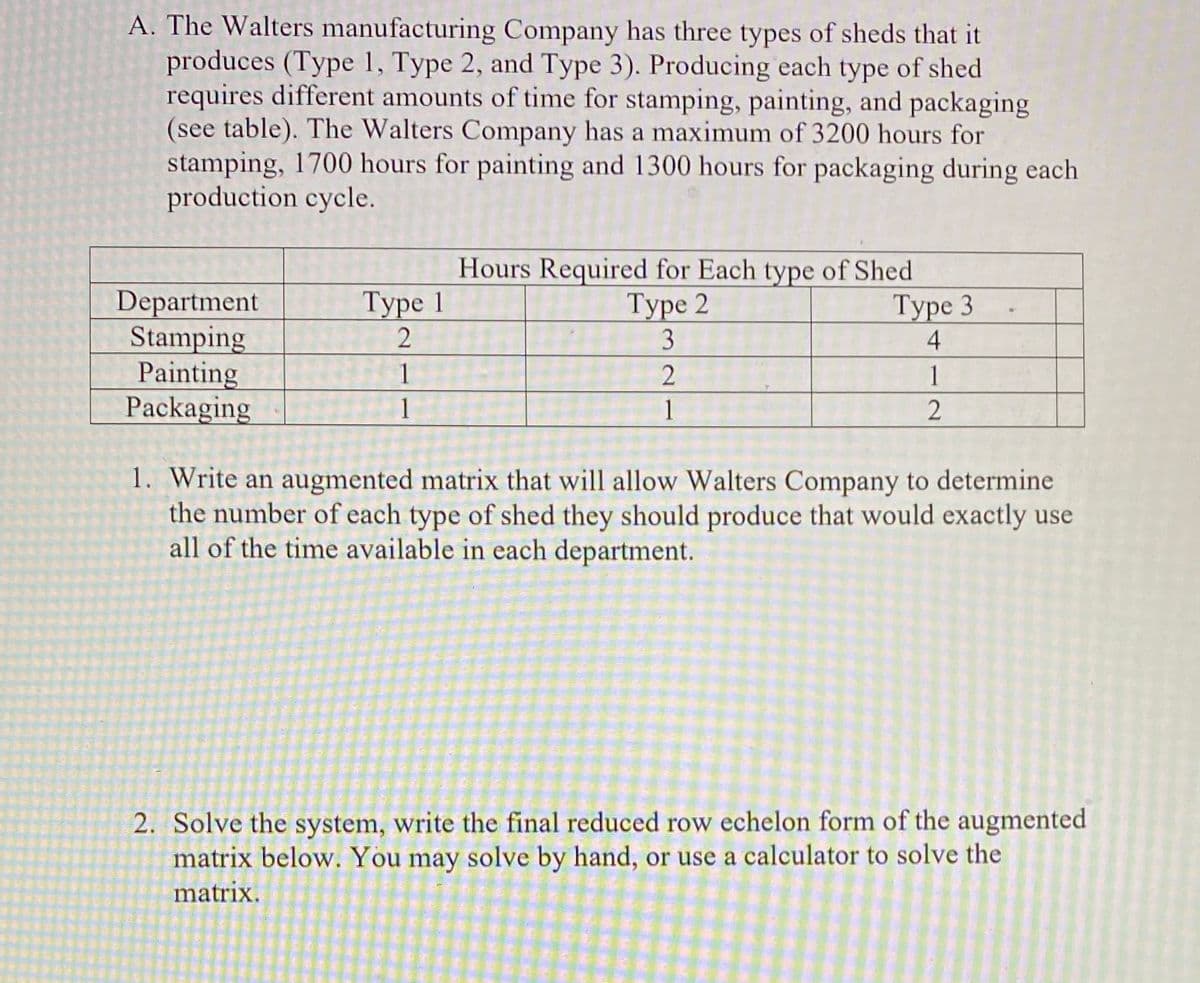A. The Walters manufacturing Company has three types of sheds that it produces (Type 1, Type 2, and Type 3). Producing each type of shed requires different amounts of time for stamping, painting, and packaging (see table). The Walters Company has a maximum of 3200 hours for stamping, 1700 hours for painting and 1300 hours for packaging during each production cycle. Туре 1 2 Hours Required for Each type of Shed Туре 2 3. Department Stamping Painting Packaging Туре 3 4. 1 1 2 1. Write an augmented matrix that will allow Walters Company to determine the number of each type of shed they should produce that would exactly use all of the time available in each department. 2. Solve the system, write the final reduced row echelon form of the augmented matrix below. You may solve by hand, or use a calculator to solve the matrix.
A. The Walters manufacturing Company has three types of sheds that it produces (Type 1, Type 2, and Type 3). Producing each type of shed requires different amounts of time for stamping, painting, and packaging (see table). The Walters Company has a maximum of 3200 hours for stamping, 1700 hours for painting and 1300 hours for packaging during each production cycle. Туре 1 2 Hours Required for Each type of Shed Туре 2 3. Department Stamping Painting Packaging Туре 3 4. 1 1 2 1. Write an augmented matrix that will allow Walters Company to determine the number of each type of shed they should produce that would exactly use all of the time available in each department. 2. Solve the system, write the final reduced row echelon form of the augmented matrix below. You may solve by hand, or use a calculator to solve the matrix.
Algebra for College Students
10th Edition
ISBN:9781285195780
Author:Jerome E. Kaufmann, Karen L. Schwitters
Publisher:Jerome E. Kaufmann, Karen L. Schwitters
Chapter11: Systems Of Equations
Section11.CT: Test
Problem 24CT
Related questions
Topic Video
Question

Transcribed Image Text:A. The Walters manufacturing Company has three types of sheds that it
produces (Type 1, Type 2, and Type 3). Producing each type of shed
requires different amounts of time for stamping, painting, and packaging
(see table). The Walters Company has a maximum of 3200 hours for
stamping, 1700 hours for painting and 1300 hours for packaging during each
production cycle.
Hours Required for Each type of Shed
Туре 3
4
Department
Stamping
Painting
Packaging
Туре 1
Туре 2
1
1
1
1
2
1. Write an augmented matrix that will allow Walters Company to determine
the number of each type of shed they should produce that would exactly use
all of the time available in each department.
2. Solve the system, write the final reduced row echelon form of the augmented
matrix below. You may solve by hand, or use a calculator to solve the
matrix.

Transcribed Image Text:2. Solve the system, write the final reduced row echelon form of the augmented
matrix below. You may solve by hand, or use a calculator to solve the
matrix.
3. How many of each type of shed should the company produce to exactly use
all of the available time in each of the departments.
Expert Solution
This question has been solved!
Explore an expertly crafted, step-by-step solution for a thorough understanding of key concepts.
This is a popular solution!
Trending now
This is a popular solution!
Step by step
Solved in 5 steps with 4 images

Knowledge Booster
Learn more about
Need a deep-dive on the concept behind this application? Look no further. Learn more about this topic, advanced-math and related others by exploring similar questions and additional content below.Recommended textbooks for you

Algebra for College Students
Algebra
ISBN:
9781285195780
Author:
Jerome E. Kaufmann, Karen L. Schwitters
Publisher:
Cengage Learning

Linear Algebra: A Modern Introduction
Algebra
ISBN:
9781285463247
Author:
David Poole
Publisher:
Cengage Learning

Algebra for College Students
Algebra
ISBN:
9781285195780
Author:
Jerome E. Kaufmann, Karen L. Schwitters
Publisher:
Cengage Learning

Linear Algebra: A Modern Introduction
Algebra
ISBN:
9781285463247
Author:
David Poole
Publisher:
Cengage Learning